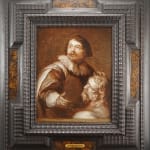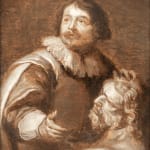Anthony van Dyck (Antwerp, 1599-London, 1641) (follower of)
Portrait of Andries Colijns de Nole, c. 1630
Oil on oak panel
19.3 x 24.2 cm (frame: 44.5 x 39.2 cm)
CHF 9'500.-
Further images
Anthony van Dyck is one of the most influential Flemish painter of the 17th century, following in the footsteps of his mentor Peter Paul Rubens. While Peter Paul Rubens' style...
Anthony van Dyck is one of the most influential Flemish painter of the 17th century, following in the footsteps of his mentor Peter Paul Rubens. While Peter Paul Rubens' style deeply shaped Anthony van Dyck's early works, the influence of Italian masters, particularly of Titian, played a crucial role in Anthony van Dyck's stylistic evolution. Extremely successful portraitist and painter of religious and mythological pictures, Anthony van Dyck was also a renowned draughtsman and etcher. Around 1630, either in Brussels or Antwerp, Anthony van Dyck realized a series of twenty-four portraits, all in grisaille or brunaille and all destined to be reproduced in engravings by Pieter de Jode to illustrate the famous Icones Principum Virorum, an album of portraits of several Antwerp personalities contemporary with Anthony van Dyck, first published in Antwerp in 1635.
The present grisaille depicts the Flemish sculptor Andries Colijns de Nole (Antwerp, 1598-Antwerp, 1638) showing the Bust of the Laocoon. Realized by an anonymous artist, this painting is based on the portrait of the same man realized by Anthony van Dyck for the illustration of the Icones Principum Virorum (the painting is today in the collection of the dukes of Buccleuch, Northamptonshire). The present portrait of Andries Colijns de Nole (Andreas Colyn de Nole) can be dated around 1630-1635 as is it based on the painting by Anthony van Dyck himself and not the engraving (the engraved portrait is reversed).
A few copies of Anthony van Dyck's Portrait of Andries Colijns de Nole are known: the catalogue raisonné (see Literature) lists three copies including one previously in the collection of the dukes of Bedford which was confused, first by Sotheby's, then by Christie's (see Provenance), with the present panel. The delicate brushstroke, the clever interplay of tones, between grisaille and brunaille, as well as some details of the sculptor's face seem to be especially close to the Portrait of Andries Colijns de Nole housed in the Mauritshuis (The Hague), a copy that is not listed in the catalogue raisonné.
The present grisaille depicts the Flemish sculptor Andries Colijns de Nole (Antwerp, 1598-Antwerp, 1638) showing the Bust of the Laocoon. Realized by an anonymous artist, this painting is based on the portrait of the same man realized by Anthony van Dyck for the illustration of the Icones Principum Virorum (the painting is today in the collection of the dukes of Buccleuch, Northamptonshire). The present portrait of Andries Colijns de Nole (Andreas Colyn de Nole) can be dated around 1630-1635 as is it based on the painting by Anthony van Dyck himself and not the engraving (the engraved portrait is reversed).
A few copies of Anthony van Dyck's Portrait of Andries Colijns de Nole are known: the catalogue raisonné (see Literature) lists three copies including one previously in the collection of the dukes of Bedford which was confused, first by Sotheby's, then by Christie's (see Provenance), with the present panel. The delicate brushstroke, the clever interplay of tones, between grisaille and brunaille, as well as some details of the sculptor's face seem to be especially close to the Portrait of Andries Colijns de Nole housed in the Mauritshuis (The Hague), a copy that is not listed in the catalogue raisonné.
Provenance
Made around 1630 by an anonymous artist probably in Antwerp.Unidentified private collection or dealer, late 19th or early 20th century: number "141" (handwritten, top left, back of the panel) probably dating from the same time as the removed paper (its trace still visible, center, back of the panel).
Unidentified private collection or dealer, probably early 20th century: "32" (handwritten, center, back of the panel) probably related to the inscription "R 7 32" (handwritten, bottom left, back of the panel).
New York, Central Pictures Galleries (sold to the following on December 16, 1951; according to Sotheby's).
New York, collection of Marc and Lilian Rojtman Berkman, and by inheritance, property of their descendants;
New York, Sotheby's, 28 January 2005, lot 736 (erroneously sold as from the collection of the dukes of Bedford).
London, Wilton Crescent, private collection;
London, Christie's, 23 July 2020, lot 125 (erroneously sold as from the collection of the dukes of Bedford);
Switzerland, private collection.
We are grateful for the Early Modern Art Research asbl (Bruxelles, Belgium) for the help regarding the provenance of the present panel.
Literature
Unpublished, see further readings:M. Mauquoy-Hendrickx (dir.), L'iconographie d'Antoine van Dyck: catalogue raisonné, Bruxelles, 1956
E. Larsen, The paintings of Anthony van Dyck, Freren, 1988.
Anthony van Dyck as a printmaker, catalogue d'exposition (Antwerp, Museum Plantino-Moretus & Stedelijk Prentenkabinet, 15 May-22 August 1999; Amsterdam, Rijksmuseum, Rijksprentenkabinet, 9 October-9January 2000), dir. C. Depauw & G. Luijten, New York, 1999.
S. J. Barnes, N. de Poorter, O. Millar & H. Vey, Van Dyck. A complete catalogue of the paintings, New Haven & London, 2004.
V. Sancho Lobis, Van Dyck, Rembrandt and the portrait print, New Haven, 2016.





